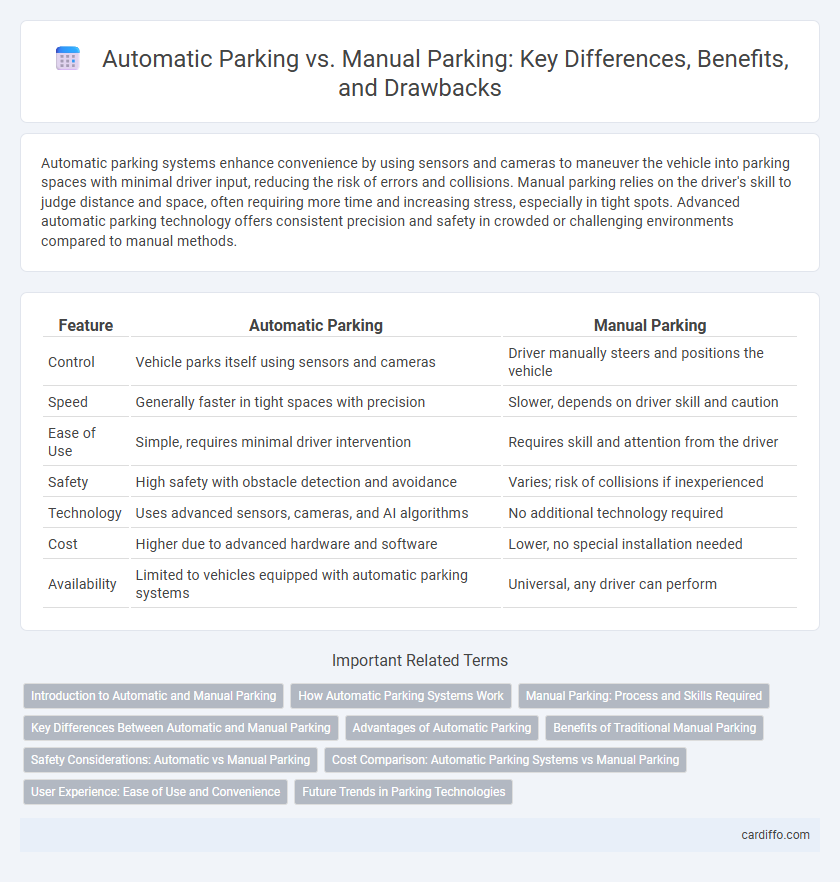Automatic parking systems enhance convenience by using sensors and cameras to maneuver the vehicle into parking spaces with minimal driver input, reducing the risk of errors and collisions. Manual parking relies on the driver's skill to judge distance and space, often requiring more time and increasing stress, especially in tight spots. Advanced automatic parking technology offers consistent precision and safety in crowded or challenging environments compared to manual methods.
Table of Comparison
| Feature | Automatic Parking | Manual Parking |
|---|---|---|
| Control | Vehicle parks itself using sensors and cameras | Driver manually steers and positions the vehicle |
| Speed | Generally faster in tight spaces with precision | Slower, depends on driver skill and caution |
| Ease of Use | Simple, requires minimal driver intervention | Requires skill and attention from the driver |
| Safety | High safety with obstacle detection and avoidance | Varies; risk of collisions if inexperienced |
| Technology | Uses advanced sensors, cameras, and AI algorithms | No additional technology required |
| Cost | Higher due to advanced hardware and software | Lower, no special installation needed |
| Availability | Limited to vehicles equipped with automatic parking systems | Universal, any driver can perform |
Introduction to Automatic and Manual Parking
Automatic parking systems utilize sensors and cameras to assist drivers in maneuvering their vehicles into parking spaces with minimal manual input, enhancing precision and reducing the risk of collisions. Manual parking relies solely on the driver's skill and spatial awareness to position the vehicle accurately within designated spots, often requiring adjustments and judgment. Advances in automatic parking technology integrate ultrasonic sensors, radar, and AI algorithms to detect obstacles and guide steering, offering convenience in tight or complex parking environments.
How Automatic Parking Systems Work
Automatic parking systems use sensors, cameras, and software algorithms to identify suitable parking spaces and maneuver the vehicle safely into position. Ultrasonic sensors detect obstacles and measure distances, enabling precise control of steering, acceleration, and braking without driver input. This technology integrates with the vehicle's onboard computer to execute parallel, perpendicular, or angled parking efficiently while minimizing the risk of collisions.
Manual Parking: Process and Skills Required
Manual parking requires precise control of the vehicle through steering, braking, and acceleration to navigate tight spaces accurately. Drivers must develop spatial awareness, clutch control (in manual transmission vehicles), and the ability to judge distances to avoid obstacles and ensure proper alignment within parking spots. Mastery of techniques such as parallel parking, reverse parking, and angle parking is essential for efficient and safe manual parking.
Key Differences Between Automatic and Manual Parking
Automatic parking systems utilize sensors and cameras to autonomously maneuver a vehicle into a parking space, enhancing precision and reducing driver effort. Manual parking requires drivers to control steering, acceleration, and braking, demanding greater skill and attention to spatial awareness. Key differences include automation level, required driver involvement, and potential for reduced collision risk with automatic systems.
Advantages of Automatic Parking
Automatic parking systems use sensors and cameras to precisely maneuver vehicles into parking spaces, significantly reducing the risk of collisions and scrapes. These systems improve ease and efficiency, especially in tight or crowded areas, by accurately controlling steering, acceleration, and braking. Drivers benefit from reduced stress and time savings, as automatic parking minimizes the need for complex maneuvers and constant adjustments.
Benefits of Traditional Manual Parking
Manual parking offers greater control and precision, allowing drivers to adjust their positioning based on real-time spatial awareness and personal judgment. It requires no reliance on sensors or software, eliminating risks associated with technological failures or calibration errors. Furthermore, traditional manual parking skills enhance driver engagement and situational awareness in complex or crowded parking environments.
Safety Considerations: Automatic vs Manual Parking
Automatic parking systems reduce human error by using sensors and cameras to safely navigate tight spaces, minimizing the risk of collisions and pedestrian accidents. Manual parking relies heavily on driver skill and awareness, which can increase the likelihood of parking lot mishaps due to misjudgment or distraction. Studies indicate that automatic parking can decrease minor parking accidents by up to 30%, enhancing overall safety in crowded urban environments.
Cost Comparison: Automatic Parking Systems vs Manual Parking
Automatic parking systems typically involve higher initial installation costs, ranging from $30,000 to $100,000 per space, due to advanced machinery and software requirements. Manual parking, while less expensive upfront with costs largely limited to lot construction and maintenance averaging $5,000 to $15,000 per space, incurs ongoing labor costs for attendants. Over time, automatic systems can reduce operational expenses by minimizing staff needs and improving space efficiency, offering cost savings that may offset higher initial investments in large-scale or high-demand areas.
User Experience: Ease of Use and Convenience
Automatic parking systems enhance user experience by simplifying the parking process through sensors and cameras, allowing drivers to park with minimal effort and increased precision. Manual parking requires greater driver skill and attention, often leading to increased stress and time consumption in tight spaces. The convenience of automatic parking reduces the likelihood of vehicle damage and improves overall confidence, especially in challenging urban environments.
Future Trends in Parking Technologies
Automatic parking systems leverage advanced sensors, AI algorithms, and machine learning to enable vehicles to park themselves with precision, reducing human error and saving time. Future trends indicate integration with smart city infrastructure, real-time data analytics, and vehicle-to-infrastructure (V2I) communication to enhance efficiency and optimize parking space utilization. Manual parking is expected to decline as autonomous vehicle technology and automated parking solutions become more prevalent and accessible.
Automatic Parking vs Manual Parking Infographic

 cardiffo.com
cardiffo.com